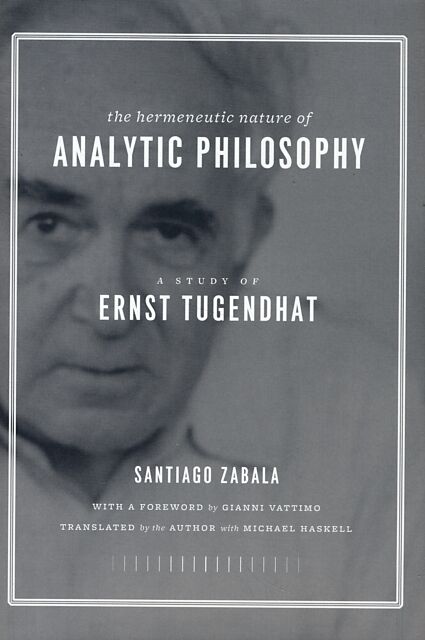The Hermeneutic Nature of Analytic Philosophy
Einband:
Fester Einband
EAN:
9780231143882
Untertitel:
A Study of Ernst Tugendhat
Genre:
Philosophie
Autor:
Santiago Zabala
Herausgeber:
Columbia University Press
Anzahl Seiten:
264
Erscheinungsdatum:
14.05.2008
ISBN:
978-0-231-14388-2
Informationen zum Autor Santiago Zabala. Foreword by Gianni Vattimo; Translated by Santiago Zabala and Michael Haskell Klappentext Contemporary philosophers-analytic as well as continental-tend to feel uneasy about Ernst Tugendhat! who! though he positions himself in the analytic field! poses questions in the Heideggerian style. Tugendhat was one of Martin Heidegger's last pupils and his least obedient! pursuing a new and controversial critical technique. Tugendhat took Heidegger's destruction of Being as presence and developed it in analytic philosophy! more specifically in semantics. Only formal semantics! according to Tugendhat! could answer the questions left open by Heidegger.Yet in doing this! Tugendhat discovered the latent "hermeneutic nature of analytic philosophy"-its post-metaphysical dimension-in which "there are no facts! but only true propositions." What Tugendhat seeks to answer is this: What is the meaning of thought following the linguistic turn? Because of the rift between analytic and continental philosophers! very few studies have been written on Tugendhat! and he has been omitted altogether from several histories of philosophy. Now that these two schools have begun to reconcile! Tugendhat has become an example of a philosopher who! in the words of Richard Rorty! "built bridges between continents and between centuries."Tugendhat is known more for his philosophical turn than for his phenomenological studies or for his position within analytic philosophy! and this creates some confusion regarding his philosophical propensities. Is Tugendhat analytic or continental? Is he a follower of Wittgenstein or Heidegger? Does he belong in the culture of analysis or in that of tradition? Santiago Zabala presents Tugendhat as an example of merged horizons! promoting a philosophical historiography that is concerned more with dialogue and less with classification. In doing so! he places us squarely within a dialogic culture of the future and proves that any such labels impoverish philosophical research. Zusammenfassung Philosophers! analytic as well as continental! tend to feel uneasy about Ernst Tugendhat! who! though he positions himself in the analytic field! poses questions in the Heideggerian style. This book aims to present Tugendhat as an example of merged horizons! and to prove that any such labels impoverish philosophical research. Inhaltsverzeichnis Translators' PrefaceForeword by Gianni VattimoIntroduction1. Overcoming Husserl: The Metaphysics of Phenomenology2. Correcting Heidegger: Verifying Heidegger's Philosophy from Within3. Semantizing Ontology: After the Metaphysics of Logical Positivism4. Philosophizing Analytically: The Semantic Foundation of PhilosophyEpilogue. The Linguistic Turn as the End of MetaphysicsNotesBibliographyIndex ...
Klappentext
Contemporary philosophers-analytic as well as continental-tend to feel uneasy about Ernst Tugendhat, who, though he positions himself in the analytic field, poses questions in the Heideggerian style. Tugendhat was one of Martin Heidegger's last pupils and his least obedient, pursuing a new and controversial critical technique. Tugendhat took Heidegger's destruction of Being as presence and developed it in analytic philosophy, more specifically in semantics. Only formal semantics, according to Tugendhat, could answer the questions left open by Heidegger.Yet in doing this, Tugendhat discovered the latent "hermeneutic nature of analytic philosophy"-its post-metaphysical dimension-in which "there are no facts, but only true propositions." What Tugendhat seeks to answer is this: What is the meaning of thought following the linguistic turn? Because of the rift between analytic and continental philosophers, very few studies have been written on Tugendhat, and he has been omitted altogether from several histories of philosophy. Now that these two schools have begun to reconcile, Tugendhat has become an example of a philosopher who, in the words of Richard Rorty, "built bridges between continents and between centuries."Tugendhat is known more for his philosophical turn than for his phenomenological studies or for his position within analytic philosophy, and this creates some confusion regarding his philosophical propensities. Is Tugendhat analytic or continental? Is he a follower of Wittgenstein or Heidegger? Does he belong in the culture of analysis or in that of tradition? Santiago Zabala presents Tugendhat as an example of merged horizons, promoting a philosophical historiography that is concerned more with dialogue and less with classification. In doing so, he places us squarely within a dialogic culture of the future and proves that any such labels impoverish philosophical research.
Zusammenfassung
Philosophers, analytic as well as continental, tend to feel uneasy about Ernst Tugendhat, who, though he positions himself in the analytic field, poses questions in the Heideggerian style. This book aims to present Tugendhat as an example of merged horizons, and to prove that any such labels impoverish philosophical research.
Inhalt
Translators' Preface Foreword by Gianni Vattimo Introduction 1. Overcoming Husserl: The Metaphysics of Phenomenology 2. Correcting Heidegger: Verifying Heidegger's Philosophy from Within 3. Semantizing Ontology: After the Metaphysics of Logical Positivism 4. Philosophizing Analytically: The Semantic Foundation of Philosophy Epilogue. The Linguistic Turn as the End of Metaphysics Notes Bibliography Index

Leider konnten wir für diesen Artikel keine Preise ermitteln ...
billigbuch.ch sucht jetzt für Sie die besten Angebote ...
Die aktuellen Verkaufspreise von 6 Onlineshops werden in Realtime abgefragt.
Sie können das gewünschte Produkt anschliessend direkt beim Anbieter Ihrer Wahl bestellen.
Loading...
Die aktuellen Verkaufspreise von 6 Onlineshops werden in Realtime abgefragt.
Sie können das gewünschte Produkt anschliessend direkt beim Anbieter Ihrer Wahl bestellen.
| # | Onlineshop | Preis CHF | Versand CHF | Total CHF | ||
|---|---|---|---|---|---|---|
| 1 | Seller | 0.00 | 0.00 | 0.00 |
